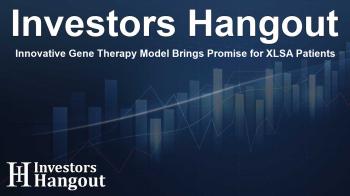Innovative Gene Therapy Model Brings Promise for XLSA Patients

Transformative Gene Therapy Model for XLSA
Researchers at Children's Hospital of Philadelphia (CHOP) and the University of Pennsylvania Perelman School of Medicine have introduced a groundbreaking gene therapy model that may revolutionize the approach to treating X-linked sideroblastic anemia (XLSA). This condition is a rare form of congenital anemia linked to mutations in the ALAS2 gene, which plays a vital role in heme production necessary for hemoglobin synthesis. By pioneering this innovative model, these researchers aim to provide hope not only for XLSA patients but also for individuals struggling with various other diseases.
Understanding XLSA and its Challenges
XLSA is a condition that historically primarily affected young males under 40. Recent studies have identified rising incidence rates among females and mid-life women, highlighting the need for effective treatments. Typical XLSA symptoms include severe anemia and iron overload, which can lead to extreme fatigue, breathlessness, and even growth delays in patients.
Many individuals diagnosed with XLSA rely on vitamin B6 supplements known as pyridoxine and blood transfusions for management. Currently, the only potential cure available is an allogenic stem cell transplantation, a procedure that remains inaccessible for most due to the challenges of finding compatible donors, prohibitive costs, and the complex chemotherapy regimen that accompanies the treatment, often resulting in severe side effects.
The Breakthrough in Gene Therapy
The recent study marks the first exploration of gene therapy as a treatment for XLSA. Using a newly-developed preclinical model, researchers investigated the possibility of employing gene therapy to alter the course of this rare disease. Carlo Castruccio Castracani, PharmD, PhD, led the research team and utilized a targeted lipid nanoparticle (LNP) technology developed by Hamideh Parhiz, PharmD, PhD, to facilitate the intentional deletion of the ALAS2 gene in hematopoietic stem cells.
Following the gene deletion, researchers observed indicators characteristic of XLSA, including anemia and spleen enlargement, as well as the presence of ring sideroblasts—immature red blood cells that are commonly identified in this condition. These observations allowed for a deeper understanding of how XLSA manifests in humans.
Significant Findings and Future Directions
Castruccio Castracani reported that the absence of the ALAS2 gene in their model coincided with an increase in premature red cells, which ultimately succumbed to cell death. They also noted metabolic defects and abnormalities in mitochondrial structure and function that hindered the formation of healthy red blood cells, contributing to the observed severe anemia.
In response, the research team developed a lentiviral vector designed to stimulate the ALAS2 gene in erythroid cells, the precursors to healthy red blood cells. This gene therapy approach demonstrated a considerable increase in hemoglobin and red blood cell counts, effectively normalizing hormone levels responsible for red blood cell production. Preclinical trials showed that subjects receiving the optimal vector doses experienced significant enhancements in hemoglobin levels and overall spleen health as well as better iron balance.
Stefano Rivella, PhD, a senior author of the study, expressed optimism regarding the potential of this new model and vector, stating, "This may be a significant leap towards improving the lives of XLSA patients. Our intention is to further adapt this model for the exploration of pharmacological treatments and in vivo gene editing to address a wider range of diseases in the future."
About Children's Hospital of Philadelphia
Children's Hospital of Philadelphia, established in 1855, is recognized as the first pediatric hospital in the United States. As a non-profit organization, it is dedicated to delivering top-notch patient care, advancing pediatric healthcare education, and spearheading extensive research initiatives. The hospital's pioneering efforts have resulted in numerous breakthroughs that benefit children globally. With one of the largest pediatric research programs in the nation, CHOP also has a comprehensive network of care facilities through its CHOP Care Network, ensuring access to high-quality pediatric services for families in Pennsylvania and New Jersey.
Frequently Asked Questions
What is X-linked sideroblastic anemia (XLSA)?
XLSA is a rare congenital anemia caused by mutations in the ALAS2 gene, affecting heme production important for hemoglobin synthesis.
Who conducted the research on the new gene therapy model?
The research was led by scientists at Children's Hospital of Philadelphia and the University of Pennsylvania Perelman School of Medicine.
How does the gene therapy model work for XLSA?
This model utilizes a lentiviral vector to stimulate the ALAS2 gene in red blood cell precursors, improving hemoglobin and red blood cell levels.
What are the symptoms of XLSA?
Symptoms commonly include severe anemia, fatigue, shortness of breath, and growth delays, often requiring blood transfusions or supplements.
What is the potential impact of this research?
The findings suggest a promising approach to treating XLSA, with future implications for broader disease treatments through gene therapy.
About The Author
Contact Thomas Cooper privately here. Or send an email with ATTN: Thomas Cooper as the subject to contact@investorshangout.com.
About Investors Hangout
Investors Hangout is a leading online stock forum for financial discussion and learning, offering a wide range of free tools and resources. It draws in traders of all levels, who exchange market knowledge, investigate trading tactics, and keep an eye on industry developments in real time. Featuring financial articles, stock message boards, quotes, charts, company profiles, and live news updates. Through cooperative learning and a wealth of informational resources, it helps users from novices creating their first portfolios to experts honing their techniques. Join Investors Hangout today: https://investorshangout.com/
The content of this article is based on factual, publicly available information and does not represent legal, financial, or investment advice. Investors Hangout does not offer financial advice, and the author is not a licensed financial advisor. Consult a qualified advisor before making any financial or investment decisions based on this article. This article should not be considered advice to purchase, sell, or hold any securities or other investments. If any of the material provided here is inaccurate, please contact us for corrections.

